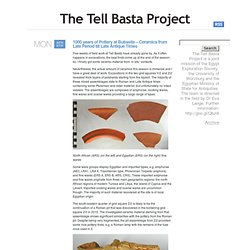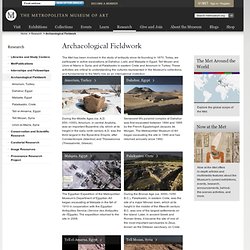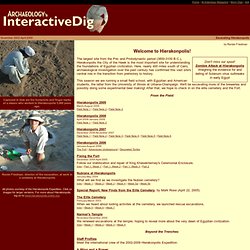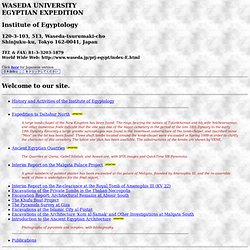

EGYPTE. Recherches en Egypte par Gigal. Saqqara.nl Homepage. Ryan-Egyptian Archeology. Nicholas Reeves. IFAO / Travaux archéologiques. British Museum blog. Amara West project blog. Temple of Amenhotep III. Tuesday, February 21, 2012 The site of Malqata is built just outside the northern end of a gigantic man-made lake (or harbor) called the Birket Habu on old maps.

The lake is outlined by huge mounds, with a double row along the desert side (for more on the Birket Habu, see the blog post for February 18, 2010 below). The best way to see this monumental piece of landscape architecture is on Google Earth, where it is very recognizable because of the straight line it makes along the edge of the desert. The Tell Basta Project. Five days of extensive 3D scanning lie behind us and we have managed to document all areas and fragments from the temple as planned.

Our surveyors, Thomas and Mark, left this morning, quite tired after working day and night! During the day they were busy in the Old Kingdom necropolis and the Middle Kingdom palace, using a 3D laser scanner. 3D-scanning the Old Kingdom necropolis using a laser scanner This special scanner is particularly employed for large site scans and offers a high accuracy of measurement for ancient structures. In a first step, the survey points of the scanner were calibrated with a total station, then the actual scanning took place, creating a point cloud. 3D scan of the Old Kingdom necropolis 3D scan of the Middle Kingdom Palace At night, it was Daniela’s and Theresa’s turn! Mark positioning the scanner Thomas and Daniela in front of the laptop Shrine fragment D/5.6 in situ Detailed scan of an inscription on shrine fragment C/6.12 Statue fragment of a Ramesside king. Dayr al-Barshā Project. Archaeological Excavations - Guardian's Egypt.
Met Museum of Art / Archaeological Fieldwork. The Met has been involved in the study of antiquity since its founding in 1870.

Today, we participate in active excavations at Dahshur, Lisht, and Malqata in Egypt; Tell Mozan and Umm el Marra in Syria; and at Palaikastro in eastern Crete and Amorium in Turkey. These activities are critical to understanding the cultures represented in the Museum's collections, and fundamental to the Met's role as an international institution. During the Middle Ages (ca. A.D. 650–1000), Amorium, in central Anatolia, was an important Byzantine city, which at its height in the early ninth century A.D. was the third largest in the Byzantine Empire, after Constantinople (Istanbul) and Thessalonica (Thessaloniki, Greece).
Senwosret III's pyramid complex at Dahshur was first excavated between 1894 and 1895 by the French Egyptologist Jacques de Morgan. Tell Mozan, the ancient city of Urkesh, is located in northeastern Syria near the Turkish border. Les Grands Ancêtres Egyptiens. Ce qui est d'ailleurs curieux mais significatif c'est que les égyptologues utilisent toujours aujourd'hui les datations de Manéthon reconnues parfaitement fiables pour tout ce qui touche aux dynasties reconnues « officiellement », mais ils évitent soigneusement tout ce qui a trait aux dynasties préhistoriques chez lui, alors qu'ils le considèrent comme le « Père » de l'égyptologie!

American Research Center in Egypt (ARCE) Amarna Project. Amarna Research Foundation. Ancient Egypt Research Associates (AERA) Egyptology and Archaeology. Archaeology Magazine. Interactive Dig Hierakonpolis. The largest site from the Pre- and Protodynastic period (3800-3100 B.C.), Hierakonpolis the City of the Hawk is the most important site for understanding the foundations of Egyptian civilization.

Here, nearly 400 miles south of Cairo, archaeological investigation over the past century has confirmed this vast site's central role in the transition from prehistory to history. This season we are running a small field school, with Egyptian and American students, the latter from the University of Illinois at Urbana-Champaign. We'll be excavating more of the breweries and possibly doing some experimental beer making! After that, we hope to check in on the elite cemetery and the Fort. From the Field: Hierakonpolis 2009March-August 2009Field Note 1 | Field Note 2 | Field Note 3 Hierakonpolis 2008April 2008-January 2009Field Note 1 | Field Note 2. Site du GREPAL : actualités de l'archéologie et l'égyptologie. Egypte ancienne. Institute of Egyptology, Waseda University. Institute of Egyptology 120-3-103, 513, Waseda-tsurumaki-cho Shinjuku-ku, Tokyo 162-0041, Japan TEL & FAX: 81-3-3203-1879World Wide Web: Click here for Japanese version Welcome to our site.

Archaeology. Terrae Antiqvae. Links. MAFTO. Sites de fouilles.